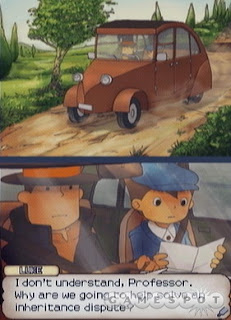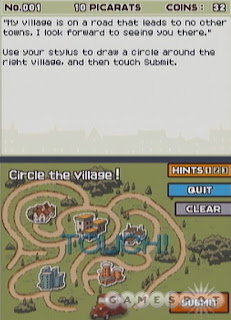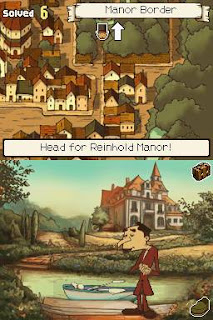Puzzle game at its finest.
Remember when you were young, your parents would buy you IQ books to "train your brain", but in actual fact, it was to shut you up? Yeah, neither did I. Anyway, fast forward to the present time. Professor Layton is the modern day IQ book with a story. Professor Layton and the Curious Village is the first game of a trilogy based on a series of books written by Professor Akira Tago. Unlike the other professor who put his own face in a game, this is primarily a puzzle game with a story, developed by Level-5, the same developers of Dragon Quest VIII. With the popularity of the DS, puzzle games are making a come back. This game is by far the most engaging yet.
STORY: The story begins with a very dead rich man, Baron Reinhalt (I know, not a good start to a story, but hey, he was rich). In his will, the Baron stated that whoever solved the mystery of "The Golden Apple" will inherit his fortune. Naturally, rich fortune attracts the sort of attentions faster than a sweet candy attracting flies. Professor Layton was invited by Lady Dahlia to solve the "The Golden Apple" mystery. So the professor and his assistant, Luke, headed out to the village. And so our story begins.
The game is set in England somewhere in an unspecified time frame (well, Layton arrived at the village in a car, so I am guessing some time in the 20th century). The village is filled with 19th century architectural designs, with the brownish orange colour palette filling in to give off a 19th century European feel. In fact, as you advance through the story, you would feel like Sherlock Holmes and "my dear Watson". The ultimate goal is to solve the mystery of the "Golden Apple", but before then, you will be confronted by hundreds of other puzzles that need solving, some given by villagers, and others you need to discover yourself.
GAMEPLAY: Professor Layton is a relatively linear adventure game. The story unfolds as you progress through the game by solving puzzles. The story is broken up into scenarios. Once you meet the objective set out in the scenario, you move on to the next one. The structure of the game is very simple and surprisingly effective. You are not bombarded with lots of information and side quests and whatnots. You have the ultimate task, which is to solve the "Golden Apple" mystery, and then you have several other bigger puzzles that are related to the story. However, the majority of the time are spent solving the 120 smaller puzzles that are present in the main storyline and most have nothing to do with the story.
These puzzles can be given to you by villagers, or hidden somewhere in town. It could be hidden anywhere, in archways, windows, chairs, lids, bookshelves, doors, lamps, even animals carry puzzles with them. Don't ask how the puzzles got there, they just are. These smaller puzzles do not derail you from your main task, and you don't feel that you are distracted by them. They are more like an obstacle you have to overcome before the villager will give you what you want, though in a similar real life situation, you might become an aggressive go-getter.
If the puzzle becomes too hard, you can always ask for hints. Each puzzle has a maximum of three hints. The third hint practically gives the answer away. It will cost you one hint coin per hint. The hint coins can be found anywhere just like hidden puzzles. Based on the difficulty of the puzzle, you will be rewarded a certain amount of 'picarats'. The harder it is, the more picarats you get. If you get it right the first time, you will be awarded the maximum picarats. However, the amount of picarat awarded will decrease for every wrong answer.
Once you get it right, you might be awarded extra items besides the picarats. These items are useful in later quests. The puzzle is also added to the "puzzle encyclopedia" so you can do them again for I don't know whatever reason, because once you solved it, you'll remember it for a long time to come. Maybe you can use them to test your friends. The stylus is your one and only control, though you can hit the 'A' button to fast forward dialogs. The top screen serves multiple functions, mainly the town map and to display the questions.
The main action is on the bottom screen. You will poke the touch screen like you have never poke before. You will be poking the screen looking for hint coins and hidden puzzles. You will also answer puzzles via the touch screen. Touch sensitivity and handwriting recognition is adequate. Some puzzles have you writing out the answer, some have you circling the answer, some have you clicking on the answer, so there are enough varieties to keep you entertained.
GRAPHICS: One thing I love about this game is that whenever you are engaged in a dialog, the top screen will display a beautifully drawn background such as the landscape if you are outside on the street, or the interior design when you are inside a building. They are colourful, vibrant and artistically done. You won't see any 3D models. But then again, you don't need to. The entire game is in 2D. But don't be put off by that.
The 2D style fits the game very well. FMV cut scenes are done in traditional anime style. Set in what feels like the 19th century England, brownish orange colour palette is used to highlight that feeling. At no point would you feel that you're transported back to the old England, though, as characters are dressed in somewhat modern clothings. You won't see jeans and T-shirts, but they are dressed accordingly.
SOUND: In game is not voiced, except for that one question when the professor or Luke wondered if they got the answers right. FMV, however, are fully voiced, and superbly done. The voice fits the character's personality well. Music are nicely rendered. Even though it loops over and over, it doesn't feel intrusive or boring. And most of time, you don't feel it's repeating at all.
REPLAYABLE: Unfortunately for these sort of games, there is no alternative path. Also, the puzzles, once solved, is pretty much the end of it. You will remember how to solve them. So there is no challenge for subsequent play through. However, there is a "secret mode" where much harder puzzles await. You must fulfil certain conditions before you have access to these puzzles. New puzzles are added each week via the Nintendo Wi-Fi network, so you can download them as well. The Japanese version already have more than a year's worth of Wi-Fi puzzles.
GOOD: Beautifully drawn animation; Beautiful detailed background; Great voice acting; Good mix of easy and challenging puzzles; Great stor.
BAD: Once puzzle is solved, you'll remember the answer
OVERALL: Professor Layton and the Curious Village mixes puzzle solving element well with the narrative to delivery a compelling story. Most puzzles, even though they have nothing to do with the story, doesn't distract you from the main plot. This game has a fine balance between story and puzzle. FMV are nicely done in anime style. This game is screaming for an anime adaptation. And I think it would do rather well as an anime.
I have said in the past that the language is the only barrier to this game, but with the English version already out and about, there is no reason not to buy it. Professor Layton and the Curious Village is definitely one puzzle that will keep you entertain for a long time. New puzzles are added every week, so you will be sure to check them out as well.
NAME: PROFESSOR LAYTON & THE CURIOUS VILLAGE
SYSTEN: Nintendo DS
















No comments:
Post a Comment